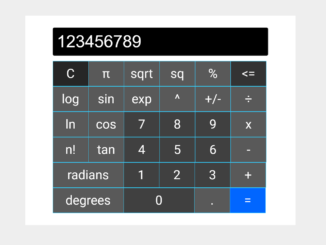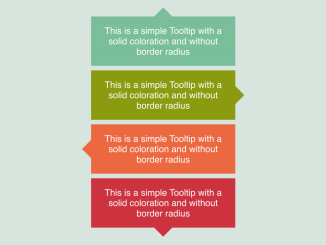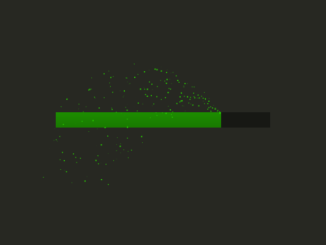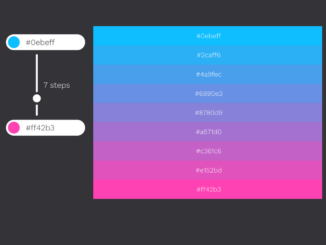
Yet another scientific calculator source code that’s written in HTML, CSS, and Vanilla JavaScript. This calculator comes with a clean design with a dark theme. Along with the basic calculations, it allows users to find out the values of sin, cos, tan, log, In, factorial, exp, radians, and degrees.
You can integrate this calculator into your web/app project to allow users to solve scientific problems quickly. The theme and styles can be highly customized with additional CSS according to your needs.
How to Create Scientific Calculator
1. In order to create a scientific calculator, create a div element with a class name "calculator". Likewise, create a div element with a class name "display" and place an input element inside it with id “output”. Similarly, create div elements for buttons, wrap all these elements into a div tag and define its class name "container". So, the complete HTML structure for the scientific calculator is as follows:
<div id="container">
<div class="calculator">
<div class="display">
<input id="output" type="text" name="" disabled/>
</div>
<div id="buttons">
<div class="row">
<div class="button" id="clear">C</div>
<div class="button">π</div>
<div class="button">sqrt</div>
<div class="button">sq</div>
<div class="button">%</div>
<div class="button" id="backspace"><=</div>
</div>
<div class="row">
<div class="button">log</div>
<div class="button">sin</div>
<div class="button">exp</div>
<div class="button">^</div>
<div class="button">+/-</div>
<div class="button">÷</div>
</div>
<div class="row">
<div class="button">ln</div>
<div class="button">cos</div>
<div class="button number">7</div>
<div class="button number">8</div>
<div class="button number">9</div>
<div class="button">x</div>
</div>
<div class="row">
<div class="button">n!</div>
<div class="button">tan</div>
<div class="button number">4</div>
<div class="button number">5</div>
<div class="button number">6</div>
<div class="button">-</div>
</div>
<div class="row">
<div class="button" id="radians">radians</div>
<div class="button number">1</div>
<div class="button number">2</div>
<div class="button number">3</div>
<div class="button">+</div>
</div>
<div class="row">
<div class="button" id="degrees">degrees</div>
<div class="button number" id="zero">0</div>
<div class="button" id>.</div>
<div class="button" id="equals">=</div>
</div>
</div>
</div>
</div>
2. After creating the HTML structure, now style the calculator using CSS. You can set the custom styles in order to customize the calculator interface. Therefore, the following are the basic CSS styles for the scientific calculator.
.calculator{
max-width: 612px;
margin: 10px auto;
}
#output {
background-color: #000;
color: #fff;
width: 100%;
height: 80px;
font-size: 48px;
border-radius: 5px;
text-align: left;
padding: 0px 10px 0px 10px;
box-shadow: 0px 0px 30px -5px #fff;
box-sizing: border-box;
}
#buttons {
margin-top: 15px;
}
.button {
color: #fff;
text-align: center;
line-height: 70px;
display: inline-block;
background-color: #595959;
border: 1px solid #33ccff;
height: 70px;
width: 100px;
font-size: 36px;
margin-right: -4.6px;
cursor: pointer;
}
.button:hover {
background-color: #0066ff;
box-shadow: 0px 0px 30px 0px #fff;
}
.button:active {
background-color: #80b3ff;
box-shadow: 0px 0px 30px 0px #000;
}
.number {
background-color: #404040;
}
.number:active {
background-color: #80b3ff;
box-shadow: 0px 0px 30px 0px #000;
}
#zero {
width: 200px;
}
#decimal {
font-weight: bold;
}
#equals {
background-color: #0066ff;
}
#equals:hover {
background-color: #fff;
color: #000;
box-shadow: 0px 0px 30px -5px #fff;
}
#backspace {
background-color: #333333;
}
#backspace:hover {
background-color: #99003d;
}
#backspace:active {
background-color: #ff4d94;
box-shadow: 0px 0px 30px 0px #000;
}
#clear {
background-color: #262626;
}
#clear:hover {
background-color: #cc0000;
}
#clear:active {
background-color: #ff4d4d;
box-shadow: 0px 0px 30px 0px #000;
}
#radians, #degrees {
width: 200px;
}
#radians:hover {
background-color: #00b38f;
}
#degrees:hover {
background-color: #00b38f;
}
3. Finally, add the following JavaScript scientific calculator program before closing the body tag and done.
var display = document.getElementById("output");
var buttons = document.getElementsByClassName("button");
Array.prototype.forEach.call(buttons, function(button) {
button.addEventListener("click", function() {
if (button.textContent != "=" && button.textContent != "C" && button.textContent != "x" && button.textContent != "÷" && button.textContent != "sqrt" && button.textContent != "sq" && button.textContent != "%" && button.textContent != "<=" && button.textContent != "+/-" && button.textContent != "sin" && button.textContent != "cos" && button.textContent != "tan" && button.textContent != "log" && button.textContent != "ln" && button.textContent != "^" && button.textContent != "n!" && button.textContent != "π" && button.textContent != "exp" && button.textContent != "radians" && button.textContent != "degrees") {
display.value += button.textContent;
} else if (button.textContent === "=") {
equals();
} else if (button.textContent === "C") {
clear();
} else if (button.textContent === "x") {
multiply();
} else if (button.textContent === "÷") {
divide();
} else if (button.textContent === "+/-") {
plusMinus();
} else if (button.textContent === "<=") {
backspace();
} else if (button.textContent === "%") {
percent();
} else if (button.textContent === "π") {
pi();
} else if (button.textContent === "sq") {
square();
} else if (button.textContent === "sqrt") {
squareRoot();
} else if (button.textContent === "sin") {
sin();
} else if (button.textContent === "cos") {
cos();
} else if (button.textContent === "tan") {
tan();
} else if (button.textContent === "log") {
log();
} else if (button.textContent === "ln") {
ln();
} else if (button.textContent === "^") {
exponent();
} else if (button.textContent === "n!") {
factorial();
} else if (button.textContent === "exp") {
exp();
} else if (button.textContent === "radians") {
radians();
} else if (button.textContent === "degrees") {
degrees();
}
});
});
// function nextLine() {
// if(display.value.length > 19) {
// document.write("\n");
// }
// }
// ***button functions***
function checkLength() {
if (display.value.length >= 23) {
display.value = "Overload Error";
}
}
function syntaxError() {
if (eval(display.value) == SyntaxError) {
display.value = "Syntax Error";
}
}
function equals() {
if ((display.value).indexOf("^") > -1) {
var base = (display.value).slice(0, (display.value).indexOf("^"));
var exponent = (display.value).slice((display.value).indexOf("^") + 1);
display.value = eval("Math.pow(" + base + "," + exponent + ")");
} else {
display.value = eval(display.value);
checkLength();
syntaxError();
}
}
function clear() {
display.value = "";
}
function backspace() {
display.value = display.value.substring(0, display.value.length - 1);
}
function multiply() {
display.value = display.value + "*";
}
function divide() {
display.value = display.value + "/";
}
function plusMinus() {
if (display.value.charAt(0) === "-") {
display.value = display.value.slice(1);
} else {
display.value = "-" + display.value;
}
}
function factorial() {
var result = 1;
if (display.value === 0) {
display.value = "1";
} else if (display.value < 0) {
display.value = "undefined";
} else {
var result = 1;
for (var i = display.value; i > 0; i--) {
result = result * i;
}
display.value = result;
}
}
function pi() {
// if(display.value === "") {
// display.value = Math.PI;
// }
display.value = (display.value * Math.PI);
}
function square() {
display.value = eval(display.value * display.value);
}
function squareRoot() {
display.value = Math.sqrt(display.value);
}
function percent() {
display.value = display.value / 100;
}
function sin() {
display.value = Math.sin(display.value);
}
function cos() {
display.value = Math.cos(display.value);
}
function tan() {
display.value = Math.tan(display.value);
}
function log() {
display.value = Math.log10(display.value);
}
function ln() {
display.value = Math.log(display.value);
}
function exponent() {
display.value = display.value + "^";
}
function exp() {
display.value = Math.exp(display.value);
}
function radians() {
display.value = display.value * (Math.PI / 180);
}
function degrees() {
display.value = display.value * (180 / Math.PI);
}
That’s all! hopefully, you have successfully integrated this scientific calculator source code into your project. If you have any questions or suggestions, let me know by comment below.
Similar Code Snippets:

I code and create web elements for amazing people around the world. I like work with new people. New people new Experiences.
I truly enjoy what I’m doing, which makes me more passionate about web development and coding. I am always ready to do challenging tasks whether it is about creating a custom CMS from scratch or customizing an existing system.











No funciona el Porcentaje %
Please check the console error. Let me know what’s problem are you facing?